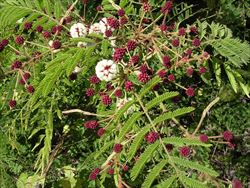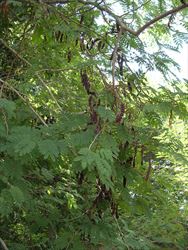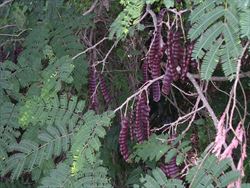- Widespread. In Australia, Fiji, PNG.
- Invasive, forming dense thickets. A shrub that grows like a vine when seeking light. Weed of sugarcane, pastures, primary and secondary forests, but also disturbed habitats, e.g., riverbanks. Threat to native species.
- Stems up to 10m long and 10cm diameter with curved thorns. Leaves, opposite, compound, 5-7 leaflets (3-7cm long), each divided into 12-18 smaller leaflets, with thorns. Flowers in clusters of 30-40 (10mm diameter) on stalks from leaf axils of upper leaves, round, cream to pale-yellow. When mature, seed pods, oblong, blackish, somewhat flattened (4.5-15cm long), with constrictions and 6-10 seeds.
- Spread: seeds by birds, animals, possibly water. Seeds used for soap/shampoo, medicines; leaves for chutneys/soups.
- Biosecurity: risk is unoffical introduction of seeds and leaves for skin/hair care and foods. Available on the Internet. Eradication attempts will require legislation (see Full Fact Sheet).
- Biocontrol: attempted but unsuccessful.
- Cultural control: hand-weed seedlings (be careful - thorns!); dig out small trees (or use heavy chains, bulldozers); clean soil and seeds from machinery/vehicles; restrict cattle from infested areas (or quarantine before moving to ‘clean’ areas); restrict movement of sand/soil.
- Chemical control: In Australia, following herbicides are registered for prickly acacia (Vachellia nilotica subsp. indica) in different situations (consult labels): fluroxypyr, triclopyr, triclopyr + picloram, fluroxypyr, hexazinome, tebuthiuron, diuron; glyphosate. In Fiji, glyphosate.
Pacific Pests, Pathogens and Weeds - Online edition
Pacific Pests, Pathogens, Weeds & Pesticides
Soap-pod (517)
Soap-pod, It is also known as soap-nut, soap pod wattle.
Senegalia rugata; previously, it was known as Acacia concinna, Acacia rugata, Mimosa rugata. It is a member of the Fabaceae.
AUTHORS Grahame Jackson, Makereta Ranadi & Nitya Singh
Information from Pedley L, Maslin BR (2018) Wattle Acaias of Australia. Department of Biodiversity, Conservation and Attractions. Western Australian Herbarium. (https://apps.lucidcentral.org/wattle/text/entities/senegalia_rugata.htm); Senegalia rugata. Wikipedia. (https://en.wikipedia.org/wiki/Senegalia_rugata); and Fern K (2021) Senegalia rugata (Lam.) Britton & Rose. Fabaceae. Tropical Plants Database. (https://tropical.theferns.info/viewtropical.php?id=Senegalia+rugata); and Senegalia rugata (Lam.) Britton & Rose. Plants of the world online. Royal Botanic Gardens, Kew. (https://powo.science.kew.org/taxon/urn:lsid:ipni.org:names:518300-1); and Weed spotters' Network Queensland (2015) DSITIA fact sheet. Queensland Herbarium, and the Department of Agriculture and Fisheries. April Bulletin. (https://www.qld.gov.au/__data/assets/pdf_file/0020/68510/weed-bulletin-apr2015.pdf); and Cairns Region Biosecurity Plan 2019-2024. Cairns Regional Council (https://www.cairns.qld.gov.au/__data/assets/pdf_file/0020/141194/CRCBiosecurityPlan2019_2024.pdf); and DAF (2020) Prickly acacia Vachellia nilotica subsp. indica (Benth) Kyal and Boatwr. Queensland Government. (https://www.daf.qld.gov.au/__data/assets/pdf_file/0007/73753/prickly-acacia.pdf); and from Waterhouse DF (1994) Biological control of weeds: Southeasat Asian Prospects. ACIAR. Canberra, Australia. 302 pp. Photo 3 Dinesh Valke from Thane, India. Acacia concinna. (https://commons.wikimedia.org/wiki/File:Acacia_concinna_(5595830208).jpg). Photo 4 Forestowlet. Acacia sinuata seen in IISc bangalore. (https://commons.wikimedia.org/wiki/File:Acacia_sinuata_02.JPG).
Produced with support from the Australian Centre for International Agricultural Research under project HORT/2016/185: Responding to emerging pest and disease threats to horticulture in the Pacific islands, implemented by the University of Queensland, in association with the Pacific Community and Koronivia Research Station, Ministry of Agriculture, Fiji.










